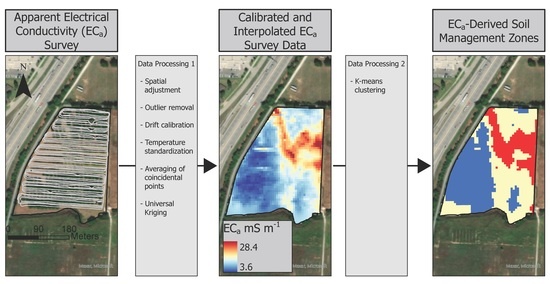Using Apparent Electrical Conductivity to Delineate Field Variation in an Agroforestry System in the Ozark Highlands
Abstract
1. Introduction
2. Materials and Methods
2.1. Site Description
2.1.1. Mapped Soils and Tree and Forage Establishment
2.1.2. Fertilizer Applications
2.2. Survey Equipment and Procedures
2.3. Weather and Soil Property Collection
2.4. ECa Survey Data Processing
2.5. Statistical Analyses
3. Results
3.1. Weather, Soil Sensor, and Soil Sample Data
3.2. ECa Survey Data
3.2.1. Monthly ECa Survey Data
3.2.2. Overall ECa Survey Data
3.2.3. SMZ Delineation
3.2.4. Correlations among ECa and Soil Properties
3.2.5. Homogeneity of Variance Assessment
4. Discussion
4.1. ECa Survey Data
4.1.1. Semi-Variogram Information
4.1.2. Monthly ECa Survey Data
4.1.3. Overall ECa Survey Data
4.1.4. Seasonal Effects on ECa
4.1.5. SMZ Delineation
4.1.6. Correlations among ECa and Soil Properties
4.1.7. Homogeneity of Variance Assessment
5. Implications
6. Conclusions
Author Contributions
Funding
Data Availability Statement
Acknowledgments
Conflicts of Interest
References
- Garcia-Tomillo, A.; Miras-Avalos, J.; Dafonte-Dafonte, J.; Paz-Gonzalez, A. Mapping Soil Texture Using Geostatistical Interpolation Combined with Electromagnetic Induction Measurements. Soil Sci. 2017, 182, 278–284. [Google Scholar] [CrossRef]
- Abdu, H.; Robinson, D.A.; Boettinger, J.; Jones, S.B. Electromagnetic Induction Mapping at Varied Soil Moisture Reveals Field-Scale Soil Textural Patterns and Gravel Lenses. Front. Agric. Sci. Eng. 2017, 4, 135–145. [Google Scholar]
- Corwin, D.L.; Scudiero, E. Field-Scale Apparent Soil Electrical Conductivity. In Methods of Soil Analysis; Logsdon, S., Ed.; Soil Science Society of America: Madison, WI, USA, 2017; Volume 1, pp. 1–29. [Google Scholar]
- Corwin, D.L.; Lesch, S.M. Characterizing Soil Spatial Variability with Apparent Soil Electrical Conductivity—Survey Protocols. Comput. Electron. Agric. 2005, 46, 103–133. [Google Scholar] [CrossRef]
- Corwin, D.L.; Lesch, S.M. Apparent Soil Electrical Conductivity Measurements in Agriculture. Comput. Electron. Agric. 2005, 46, 11–43. [Google Scholar] [CrossRef]
- Johnson, C.K.; Doran, J.W.; Duke, H.R.; Wienhold, B.J.; Eskridge, K.M.; Shanahan, J.F. Field-scale Electrical Conductivity Mapping for Delineating Soil Condition. Soil Sci. Soc. Am. J. 2001, 65, 1829–1837. [Google Scholar]
- Heil, K.; Schmidhalter, U. The Application of EM38: Determination of Soil Parameters, Selection of Soil Sampling Points and Use in Agriculture and Archaeology. Sensors 2017, 17, 2540. [Google Scholar] [CrossRef]
- Agroforestry Practices. Available online: https://www.fs.usda.gov/nac/practices/index.shtml (accessed on 29 June 2022).
- Dollinger, J.; Jose, S. Agroforestry for Soil Health. Agrofor. Syst. 2018, 92, 213–219. [Google Scholar]
- Jose, S. Agroforestry for Ecosystem Services and Environmental Benefits: An Overview. Agrofor. Syst. 2009, 76, 1–10. [Google Scholar] [CrossRef]
- Brye, K.R.; West, C.P. Grassland Management Effects on Soil Surface Properties in the Ozark Highlands. Soil Sci. 2005, 170, 63–73. [Google Scholar] [CrossRef]
- Natural Resources Conservation Service. Land Resource Regions and Major Land Resource Areas of the United States, the Caribbean, and the Pacific Basin. In USDA Handbook 296; Government Printing Office: Washington, DC, USA, 2006; pp. 373–375. [Google Scholar]
- Major Land Resource Areas. Available online: https://data.nal.usda.gov/dataset/major-land-resource-areas-mlra (accessed on 23 June 2022).
- Web Soil Survey. Available online: https://websoilsurvey.sc.egov.usda.gov/App/WebSoilSurvey.aspx (accessed on 23 June 2022).
- Ashworth, A.J.; Adams, T.C.; Kharel, T.; Philip, D.; Owens, P.R.; Sauer, T. Root Decomposition in Silvopastures Is Influenced by Grazing, Fertility, and Grass Species. Agrosyst. Geosci. Environ. 2021, 4, e20190. [Google Scholar] [CrossRef]
- Data Tools: 1981–2010 Normals. Fayetteville Experimental Station, AR USA. Available online: https://www.ncei.noaa.gov/access/us-climate-normals/#dataset=normals-monthly&timeframe=81 (accessed on 23 June 2022).
- Sauer, T.J.; Coblentz, W.K.; Thomas, A.L.; Brye, K.R.; Brauer, D.K.; Skinner, J.V.; Brahana, J.V.; DeFauw, S.L.; Hays, P.D.; Moffit, D.C.; et al. Nutrient Cycling in an Agroforestry Alley Cropping System Receiving Poultry Litter or Nitrogen Fertilizer. Nutr. Cycl. Agroecosyst. 2014, 101, 167–179. [Google Scholar] [CrossRef]
- Niyigena, V.; Ashworth, A.J.; Nieman, C.; Acharya, M.; Coffey, K.P.; Philipp, D.; Meadors, L.; Sauer, T.J. Factors Affecting Sugar Accumulation and Fluxes in Warm- and Cool-Season Forages Grown in a Silvopastoral System. Agronomy 2021, 11, 354. [Google Scholar] [CrossRef]
- Gurmessa, B.; Ashworth, A.J.; Yang, Y.; Adhikari, K.; Savin, M.; Owens, P.R.; Sauer, T.J.; Pedretti, E.F.; Cocco, S.; Corti, G. Soil Bacterial Diversity Based on Management and Topography in a Silvopastoral System. Appl. Soil Ecol. 2021, 163, 103918. [Google Scholar] [CrossRef]
- Adams, T.; Ashworth, A.J.; Sauer, T. Soil CO2 Evolution Is Driven by Forage Species, Soil Moisture, Grazing Pressure, Poultry Litter Fertilization, and Seasonality in Silvopastures. Agrosyst. Geosci. Environ. 2021, 4, e20179. [Google Scholar] [CrossRef]
- Adhikari, K.; Owens, P.R.; Ashworth, A.J.; Sauer, T.J.; Libohova, Z.; Miller, D.M. Topographic Controls on Soil Nutrient Variations in a Silvopasture System. Agrosyst. Geosci. Environ. 2018, 1, 1–15. [Google Scholar] [CrossRef]
- Amorim, H.C.S.; Ashworth, A.J.; Sauer, T.J.; Zinn, Y.L. Soil Organic Carbon and Fertility Based on Tree Species and Management in a 17-Year Agroforestry Site. Agronomy 2022, 12, 1–13. [Google Scholar]
- Ashworth, A.J.; Kharel, T.; Sauer, T.; Adams, T.C.; Philip, D.; Thomas, A.L.; Owens, P.R. Spatial Monitoring Technologies for Coupling the Soil Plant Water Animal Nexus. Sci. Rep. 2022, 12, 3508. [Google Scholar] [CrossRef]
- DeFauw, S.L.; Brye, K.R.; Sauer, T.J.; Hays, P. Hydraulic and Physiochemical Properties of a Hillslope Soil Assemblage in the Ozark Highlands. Soil Sci. 2014, 179, 107–117. [Google Scholar] [CrossRef]
- Dold, C.; Thomas, A.L.; Ashworth, A.J.; Philipp, D.; Brauer, D.K.; Sauer, T.J. Carbon Sequestration and Nitrogen Uptake in a Temperate Silvopasture System. Nutr. Cycl. Agroecosyst. 2019, 114, 85–98. [Google Scholar] [CrossRef]
- Jiang, Z.-D.; Owens, P.R.; Ashworth, A.J.; Ponce, B.F.; Thomas, A.L.; Sauer, T. Evaluating Tree Growth Factors into Species-Specific Functional Soil Maps for Improved Agroforestry System Efficiency. Agrofor. Syst. 2021, 96, 479–490. [Google Scholar] [CrossRef]
- Kharel, T.P.; Ashworth, A.J.; Owens, P.R.; Philipp, D.; Thomas, A.L.; Sauer, T. Teasing Apart Silvopasture System Components Using Machine Learning for Optimization. Soil Syst. 2021, 5, 41. [Google Scholar] [CrossRef]
- O’Brien, P.L.; Thomas, A.L.; Sauer, T.J.; Brauer, D.K. Foliar Nutrient Concentrations of Three Economically Important Tree Species in an Alley-cropping System. J. Plant Nutr. 2020, 43, 2557–2568. [Google Scholar] [CrossRef]
- Thomas, A.L.; Brauer, D.K.; Sauer, T.J.; Coggeshall, M.V.; Ellersieck, M.R. Cultivar Influences Early Rootstock and Scion Survival of Grafted Black Walnut. J. Am. Pomol. Soc. 2008, 62, 3–12. [Google Scholar]
- Ylagan, S.; Amorim, H.C.S.; Ashworth, A.J.; Sauer, T.; Wienhold, B.J.; Owens, P.R.; Zinn, Y.L.; Brye, K.R. Soil Quality Assessment of an Agroforestry System Following Long-Term Management in the Ozark Highlands. Agrosyst. Geosci. Environ. 2021, 4, e20194. [Google Scholar] [CrossRef]
- Abdu, H.; Robinson, D.; Jones, S. Comparing Bulk Soil Electrical Conductivity Determination Using the DUALEM-1S and EM38-DD Electromagnetic Induction Instruments. Soil Sci. Soc. Am. J. 2007, 71, 189–196. [Google Scholar] [CrossRef]
- Simpson, D.; Lehouck, A.; Verdonck, L.; Vermeersch, H.; Meirvenne, M.; Bourgeois, J.; Thoen, E.; Docter, R. Comparison between Electromagnetic Induction and Fluxgate Gradiometer Measurements on the Buried Remains of a 17th Century Castle. J. Appl. Geophys. 2009, 68, 294–300. [Google Scholar] [CrossRef]
- Rudolph, S.; Wongleecharoen, C.; Lark, R.M.; Marchant, B.P.; Garré, S.; Herbst, M.; Vereecken, H.; Weihermüller, L. Soil Apparent Conductivity Measurements for Planning and Analysis of Agricultural Experiments: A Case Study from Western-Thailand. Geoderma 2016, 267, 220–229. [Google Scholar] [CrossRef]
- Martini, E.; Werban, U.; Zacharias, S.; Pohle, M.; Dietrich, P.; Wollschläger, U. Repeated Electromagnetic Induction Measurements for Mapping Soil Moisture at the Field Scale: Validation with Data from a Wireless Soil Moisture Monitoring Network. Hydrol. Earth Syst. Sci. 2017, 21, 495–513. [Google Scholar] [CrossRef]
- Pearson, R.K.; Neuvo, Y.; Astola, J.; Gabbouj, M. Generalized Hampel Filters. EURASIP J. Adv. Signal Process. 2016, 87, 1–18. [Google Scholar] [CrossRef]
- Borchers, H.W. Pracma: Practical Numerical Math Functions. R Package Version 2.3.3. 2021. Available online: https://rdrr.io/cran/pracma/ (accessed on 13 October 2022).
- Delefortrie, S.; Smedt, P.; Saey, T.; Vijver, E.; Meirvenne, M. An Efficient Calibration Procedure for Correction of Drift in EMI Survey Data. J. Appl. Geophys. 2014, 110, 115–125. [Google Scholar] [CrossRef]
- Hijmans, R.J. Geosphere: Spherical Trigonometry. R Package Version 1.5.10. 2019. Available online: https://rdrr.io/cran/geosphere/ (accessed on 13 October 2022).
- Pebesma, E.; Bivand, R.; Rowlingson, B.; Gomez-Rubio, V. Sp: Package Providing Classes and Methods for Spatial Data: Points, Lines, Polygons and Grids. R Package Version 2.0.7. 2005. Available online: https://rsbivand.github.io/sp/reference/00sp.html (accessed on 13 October 2022).
- Bivand, R.; Keitt, T.; Rowlingson, B. Rgdal: Bindings for the “Geospatial” Data Abstraction Library. R Package Version 1.5.23. 2021. Available online: https://www.rdocumentation.org/packages/rgdal/versions/1.5-32 (accessed on 13 October 2022).
- Pebesma, E.J. Gstat: Multivariable Geostatisitcs in S. R Package Version 2.0.8. 2004. Available online: https://www.rdocumentation.org/packages/gstat/versions/2.1-0 (accessed on 13 October 2022).
- Padgham, M.; Sumner, M.D. Geodist: Fast, Dependency-Free Geodesic Distance Calculations. R Package Version 0.0.7. 2021. Available online: https://hypertidy.github.io/geodist/ (accessed on 13 October 2022).
- Hijmans, R.J. Raster: Geographic Data Analysis and Modeling. R Package Version 3.4.10. 2021. Available online: https://rdrr.io/cran/raster/#:~:text=raster%3A%20Geographic%20Data%20Analysis%20and%20Modeling%20Reading%2C%20writing%2C,and%20for%20vector%20data%20operations%20such%20as%20intersections (accessed on 13 October 2022).
- Hijmans, R.J. Terra: Spatial Data Analysis. R Package Version 1.2.10. 2021. Available online: https://rdrr.io/cran/terra/ (accessed on 13 October 2022).
- Growing Season Dates and Length. Available online: https://www.nrcs.usda.gov/wps/portal/wcc/home/climateSupport/wetlandsClimateTables/growingSeasonDatesLength/ (accessed on 23 June 2022).
- Hartigan, J.A. Clustering Algorithms; John Wiley & Sons: Hoboken, NJ, USA, 1975; pp. 1–351. [Google Scholar]
- Kassambara, A.; Mundt, F. Factoextra: Extract and Visualize the Results of Multivariate Data Analyses. R Package Version 1.0.7. 2020. Available online: https://cran.r-project.org/web/packages/factoextra/readme/README.html (accessed on 13 October 2022).
- Zhu, Q.; Lin, H.; Doolittle, J. Repeated Electromagnetic Induction Surveys for Determining Subsurface Hydrologic Dynamics in an Agricultural Landscape. Soil Sci. Soc. Am. J. 2010, 74, 1750–1762. [Google Scholar] [CrossRef]
- Skøien, J.O.; Blöschl, G. Scale Effects in Estimating the Variogram and Implications for Soil Hydrology. Vadose Zone J. 2006, 5, 153–167. [Google Scholar] [CrossRef]
- DeCaires, S.A.; Wuddivira, M.N.; Bekele, I. Assessing the Temporal Stability of Spatial Patterns of Soil Apparent Electrical Conductivity Using Geophysical Methods. Int. Agrophys. 2014, 28, 423–433. [Google Scholar]
- Khakural, B.R.; Robert, P.C.; Hugins, D.R. Use of Non-contacting Electromagnetic Inductive Method for Estimating Soil Moisture Across a Landscape. Commun. Soil Sci. Plant Anal. 1998, 29, 2055–2065. [Google Scholar] [CrossRef]
- Western, A.W.; Blöschl, G.; Grayson, R.B. Geostatistical Characterization of Soil Moisture Patterns in the Tarrawarra Catchment. J. Hydrol. 1998, 205, 20–37. [Google Scholar] [CrossRef]
- Smith, H.; Ashworth, A.J.; Owens, P.R. Applications and Analytical Methods of Ground Penetrating Radar for Soil Characterization in a Silvopastoral System. J. Environ. Eng. Geophys. 2022. accepted. [Google Scholar]
- Burgess-Conforti, J.R.; Moore, P.A.; Owens, P.R.; Miller, D.M.; Ashworth, A.J.; Hays, P.D.; Evans-White, M.A.; Anderson, K.R. Are Soils beneath Coniferous Tree Stands More Acidic than Soils beneath Deciduous Tree Stands? Environ. Sci. Pollut. Res. 2019, 26, 14920–14929. [Google Scholar] [CrossRef]
- Harvey, O.R.; Morgan, C.L.S. Predicting Regional-Scale Soil Variability Using a Single Calibrated Apparent Soil Electrical Conductivity Model. Soil Sci. Soc. Am. J. 2009, 73, 164–169. [Google Scholar] [CrossRef]
- Corwin, D.L.; Scudiero, E. Mapping Soil Spatial Variability with Apparent Soil Electrical Conductivity (ECa) Directed Soil Sampling. Soil Sci. Soc. Am. J. 2019, 83, 3–4. [Google Scholar] [CrossRef]
- Chow, T.L.; Rees, H.W.; Monteith, J.O.; Toner, P.; Lavoie, J. Effects of Coarse Fragment Content on Soil Physical Properties, Soil Erosion and Potato Production. Can. J. Soil Sci. 2007, 87, 565–577. [Google Scholar] [CrossRef]
- Brevik, E.C.; Fenton, T.E.; Lazari, A. Soil Electrical Conductivity as a Function of Soil Water Content and Implications for Soil Mapping. Precis. Agric. 2006, 7, 393–404. [Google Scholar] [CrossRef]
- Food Agriculture Organization. FAO/Unesco Soil Map of the World, Revised Legend, with Corrections and Updates (Technical paper 20); FAO: Rome, Italy, 1988; pp. 1–146. [Google Scholar]
- Corwin, D.L.; Lesch, S.M.; Shouse, P.J.; Soppe, R.; Ayars, J.E. Identifying Soil Properties That Influence Cotton Yield Using Soil Sampling Directed by Apparent Soil Electrical Conductivity. Agron. J. 2003, 95, 352–364. [Google Scholar] [CrossRef]
- Johnson, C.K.; Mortensen, D.A.; Wienhold, B.J.; Shanahan, J.F.; Doran, J.W. Site-Specific Management Zones Based on Soil Electrical Conductivity in a Semiarid Cropping System. Agron. J. 2003, 95, 303–315. [Google Scholar] [CrossRef]
- Bongiovanni, R.; Lowenberg-Deboer, J. Precision Agriculture and Sustainability. Precis. Agric. 2004, 5, 359–387. [Google Scholar] [CrossRef]
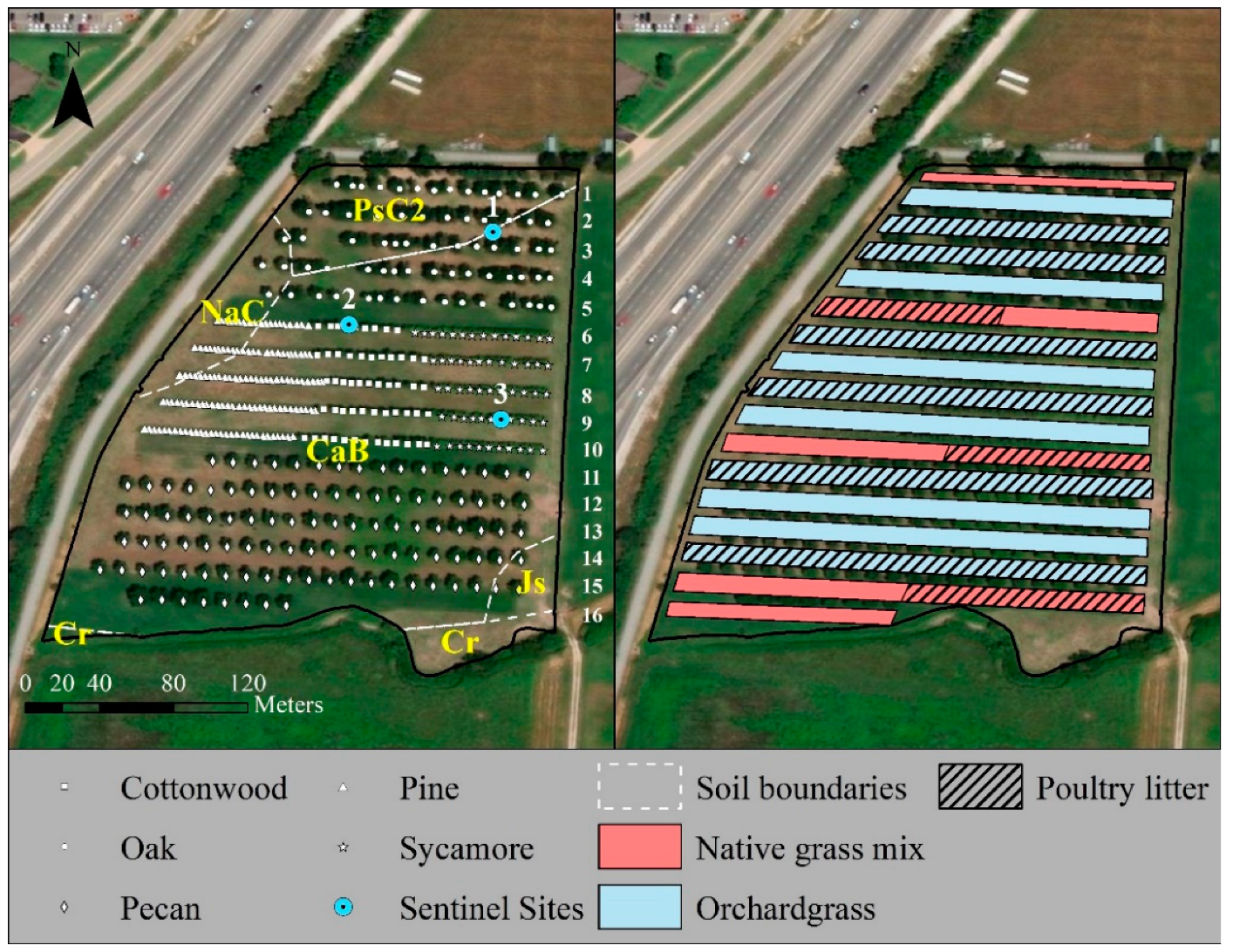
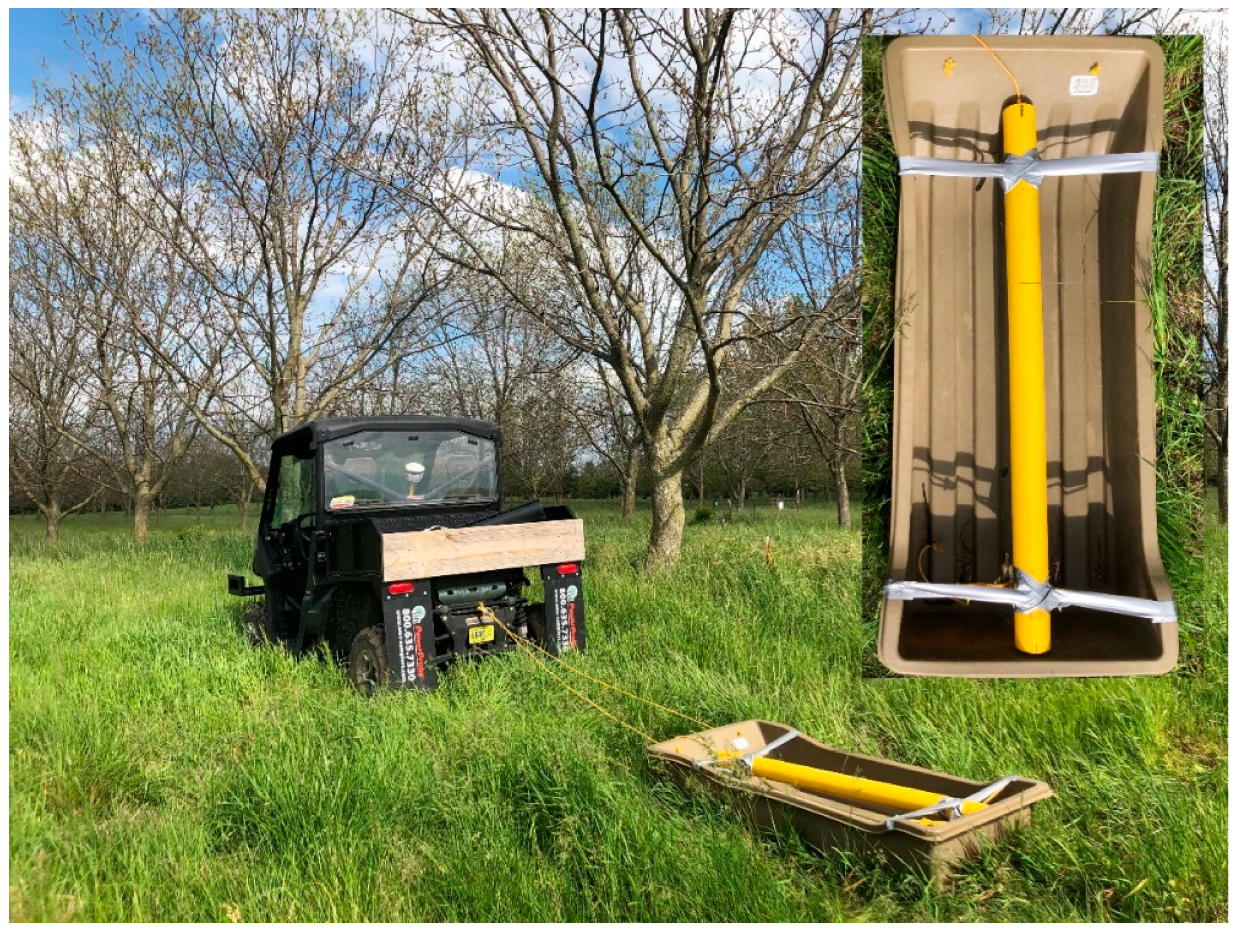
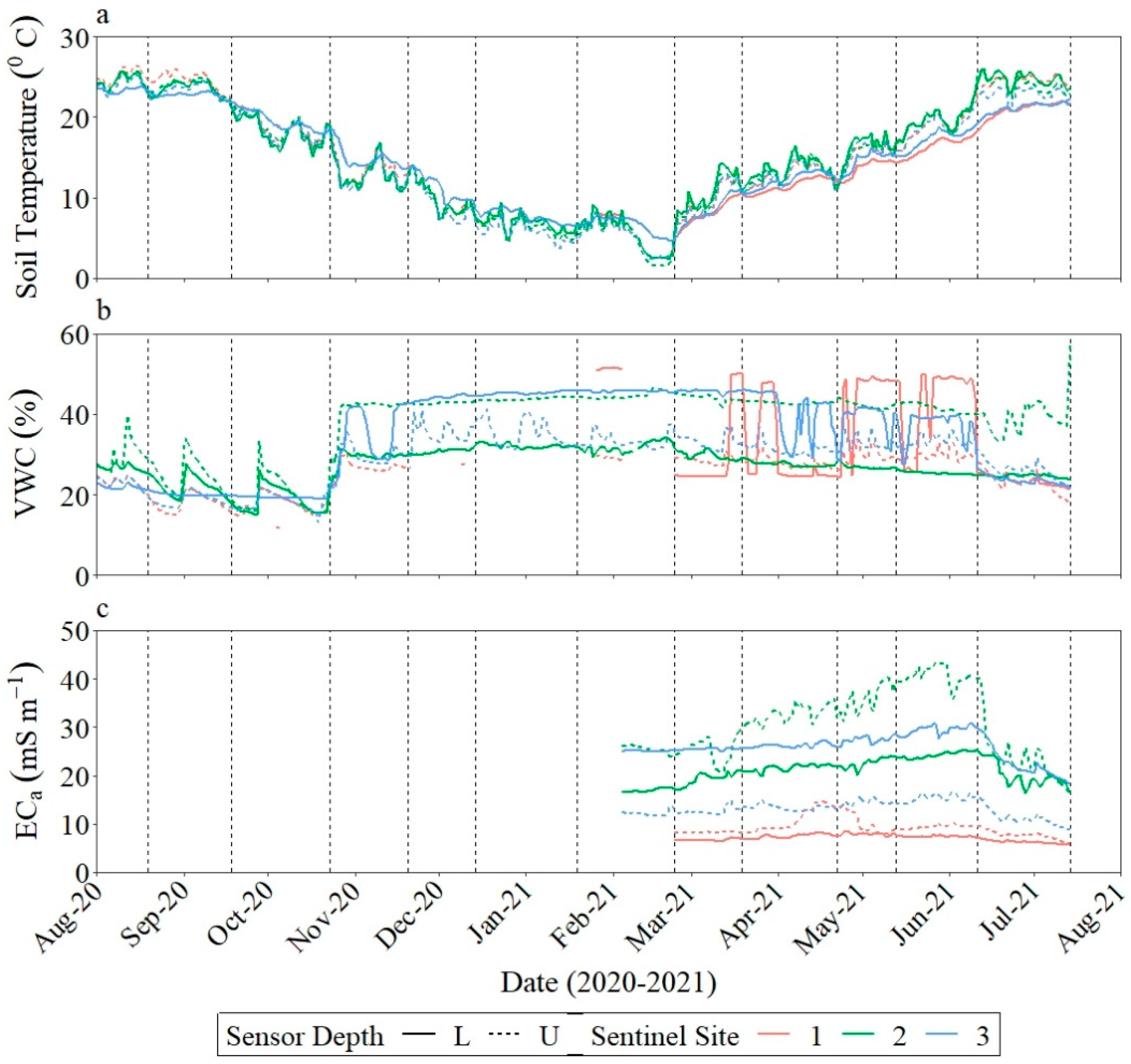
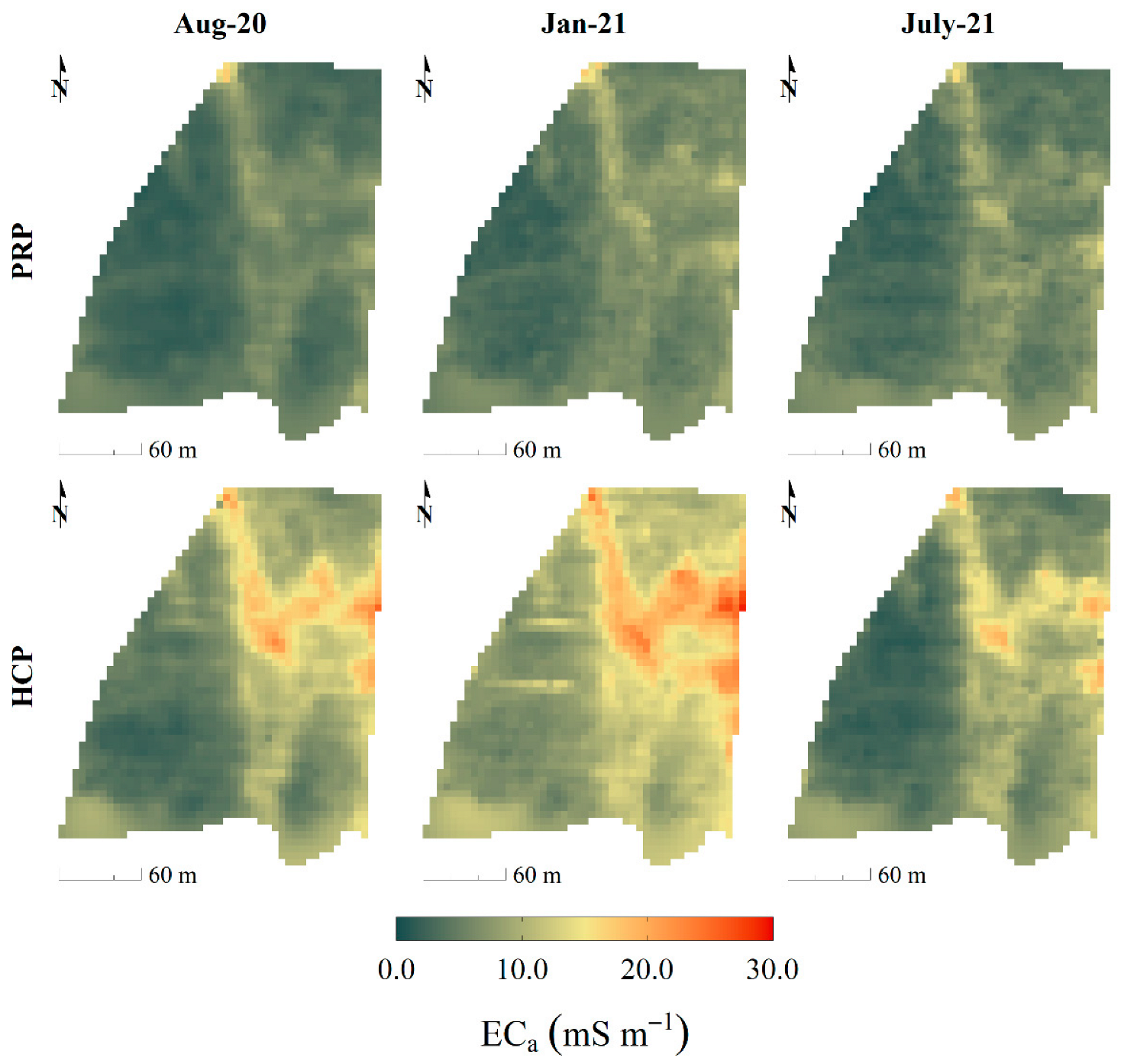

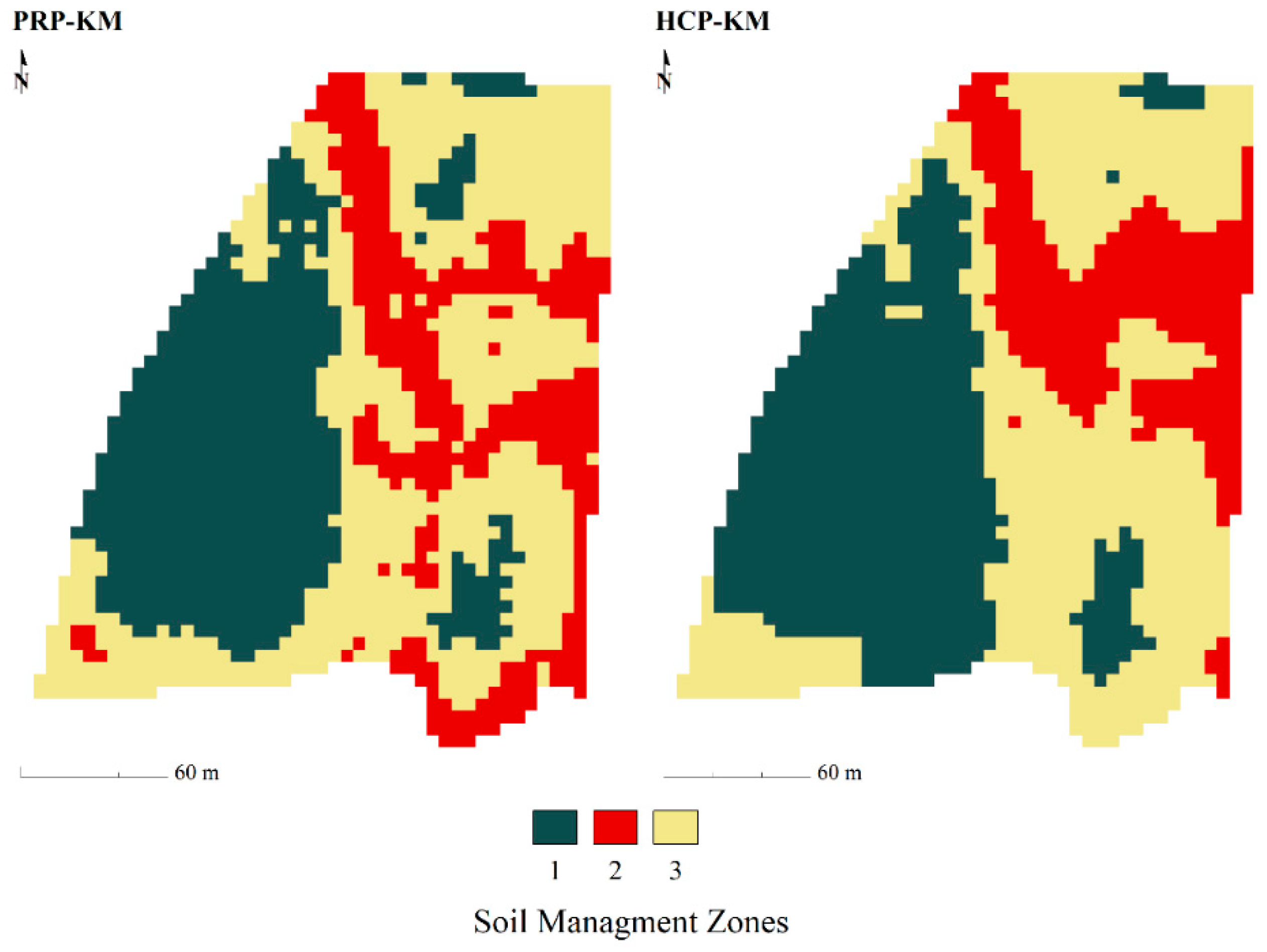
| 2016–2021 Tree Fertilizer Application Rates per Tree Species | |||||||||||
|---|---|---|---|---|---|---|---|---|---|---|---|
| Fertilizer Amount * | Fertilizer Application Area | ||||||||||
| Year | Fertilizer | Oak | Pec | Syc | Cot | Pine | Oak | Pec | Syc | Cot | Pine |
| __________ kg tree−1 ___________ | |||||||||||
| 2016 | NH4NO3 | 0.52–1.0 | 2.3 | 0.20 | 0.20 | 0.20 | 2.4–4.9 × 6.11 m area | 9.1 m diameter area | 2.3 × 2.4 m area | 2.3 × 2.4 m area | 2.3 × 2.4 m area |
| 13-13-13 † | 1.3–2.6 | 5.7 | 0.48 | 0.48 | 0.48 | ||||||
| Gypsum | 0.27–0.54 | 1.2 | 0.10 | 0.10 | 0.10 | ||||||
| 2017 | 32-0-0 †† | 1.0 | 2.3 | 0.20 | 0.20 | 0.20 | 4.9 × 6.11 m area | 9.1 m diameter area | 2.3 × 2.4 m area | 2.3 × 2.4 m area | 2.3 × 2.4 m area |
| 13-13-13 | 2.6 | 5.7 | 0.48 | 0.48 | 0.48 | ||||||
| Gypsum | 0.5 | 1.2 | 0.10 | 0.10 | 0.10 | ||||||
| 2018 | NH4NO3 | 3.5 | 4.7 | 0.44 | 0.55 | 0.30 | 9.1 m diameter area | 10.7 m diameter area | 2.3 × 3.7 m area | 2.3 × 4.6 m area | 2.3 × 2.4 m area |
| 13-13-13 | 8.5 | 11.5 | 1.1 | 1.4 | 0.72 | ||||||
| Gypsum | 1.8 | 2.4 | 0.23 | 0.29 | 0.15 | ||||||
| 2019 | NH4NO3 | 3.5 | 4.7 | 0.44 | 0.55 | 0.30 | 9.1 m diameter area | 10.7 m diameter area | 2.3 × 3.7 m area | 2.3 × 4.6 m area | 2.3 × 2.4 m area |
| 13-13-13 | 8.5 | 11.5 | 1.1 | 1.4 | 0.72 | ||||||
| Gypsum | 1.8 | 2.4 | 0.23 | 0.29 | 0.15 | ||||||
| 2020 | NH4NO3 | 3.5 | 4.7 | 0.87 | 0.87 | 0.30 | 9.1 m diameter area | 10.7 m diameter area | 4.6 m diameter area | 4.6 m diameter area | 2.3 × 2.4 m area |
| 13-13-13 | 8.5 | 11.5 | 2.1 | 2.1 | 0.72 | ||||||
| Gypsum | 1.8 | 2.4 | 0.45 | 0.45 | 0.15 | ||||||
| 2021 | 13-13-13 | - | - | - | - | 0.50 | - | - | - | - | 2.0 m diameter area |
| Seasonal Groupings | Test Groupings †† | |||||||
|---|---|---|---|---|---|---|---|---|
| Survey | Survey (Month-Year) | Weather Season | Growing † Season | H1 | H2 | MS | MFS | MWS |
| 1 | August-2020 | Summer | GS | X | ||||
| 2 | September-2020 | Fall | GS | X | ||||
| 3 | October-2020 | Fall | GS | X | X | X | ||
| 4 | November-2020 | Fall | NGS | X | ||||
| 5 | December-2020 | Winter | NGS | X | ||||
| 6 | January-2021 | Winter | NGS | X | X | X | ||
| 7 | February-2021 | Winter | GS | X | ||||
| 8 | March-2021 | Spring | GS | X | ||||
| 9 | April-2021 | Spring | GS | X | X | X | ||
| 10 | May-2021 | Spring | GS | X | ||||
| 11 | June-2021 | Summer | GS | X | ||||
| 12 | July-2021 | Summer | GS | X | X | X | ||
| Semi-Variogram Information | Kriged Survey Summary Statistics | |||||||||||
|---|---|---|---|---|---|---|---|---|---|---|---|---|
| ECa Type | Survey | Date (Month-Year) | Survey Points | Model | Nugget | Sill | Range | Mean | Min | Max | SD | CV |
| m | _________ mS m−1 _________ | % | ||||||||||
| PRP | 1 | August-2020 | 5271 | Exponential | 0.61 | 4.8 | 39.4 | 4.2 | 1.0 | 17.0 | 1.9 | 44.1 |
| 2 | September-2020 | 5422 | Matern | 0.18 | 3.5 | 34.4 | 3.4 | 0.4 | 14.6 | 1.7 | 48.1 | |
| 3 | October-2020 | 5769 | Exponential | 0.17 | 3.7 | 28.9 | 4.6 | 0.9 | 16.6 | 1.9 | 42.1 | |
| 4 | November-2020 | 6083 | Exponential | 0.38 | 5.0 | 41.4 | 7.4 | 2.3 | 18.2 | 2.4 | 32.2 | |
| 5 | December-2020 | 6085 | Exponential | 0.30 | 4.8 | 29.3 | 6.7 | 2.6 | 21.0 | 2.3 | 34.1 | |
| 6 | January-2021 | 6340 | Exponential | 0.10 | 3.6 | 27.8 | 5.5 | 1.4 | 17.2 | 2.1 | 38.0 | |
| 7 | February-2021 | 5777 | Exponential | 0.00 | 3.7 | 26.8 | 6.2 | 1.7 | 20.5 | 2.3 | 36.3 | |
| 8 | March-2021 | 6173 | Exponential | 0.10 | 5.6 | 24.0 | 5.9 | 1.3 | 21.9 | 2.5 | 41.8 | |
| 9 | April-2021 | 6329 | Exponential | 0.03 | 6.0 | 25.3 | 5.5 | 0.6 | 17.6 | 2.6 | 46.8 | |
| 10 | May-2021 | 6854 | Exponential | 0.00 | 8.4 | 24.0 | 7.5 | 2.2 | 21.4 | 2.9 | 38.6 | |
| 11 | June-2021 | 6671 | Matern | 0.00 | 13.1 | 27.6 | 8.7 | 2.7 | 29.1 | 3.6 | 41.2 | |
| 12 | July-2021 | 6527 | Exponential | 0.18 | 4.2 | 27.7 | 5.1 | 0.2 | 15.9 | 2.1 | 40.3 | |
| HCP | 1 | August-2020 | 5271 | Spherical | 0.25 | 16.5 | 97.9 | 8.6 | 1.6 | 25.5 | 4.4 | 51.2 |
| 2 | September-2020 | 5422 | Circular | 0.14 | 13.8 | 84.0 | 6.7 | 0.4 | 19.7 | 4.1 | 61.1 | |
| 3 | October-2020 | 5769 | Spherical | 0.32 | 14.3 | 91.6 | 9.9 | 3.6 | 25.6 | 4.1 | 41.2 | |
| 4 | November-2020 | 6083 | Matern | 0.08 | 15.9 | 60.0 | 9.8 | 2.9 | 26.2 | 4.2 | 42.1 | |
| 5 | December-2020 | 6085 | Matern | 0.00 | 15.7 | 50.0 | 12.3 | 3.6 | 28.4 | 4.4 | 35.9 | |
| 6 | January-2021 | 6340 | Matern | 0.00 | 14.6 | 48.9 | 11.7 | 4.4 | 29.2 | 4.2 | 36.4 | |
| 7 | February-2021 | 5777 | Matern | 0.00 | 15.2 | 58.9 | 8.8 | 2.2 | 23.6 | 4.2 | 47.5 | |
| 8 | March-2021 | 6173 | Matern | 0.00 | 16.0 | 42.1 | 11.9 | 4.8 | 34.2 | 4.2 | 35.5 | |
| 9 | April-2021 | 6329 | Exponential | 0.00 | 16.5 | 43.2 | 11.6 | 4.1 | 27.2 | 4.2 | 36.3 | |
| 10 | May-2021 | 6854 | Matern | 0.00 | 18.9 | 46.1 | 9.7 | 2.0 | 31.4 | 4.4 | 45.6 | |
| 11 | June-2021 | 6671 | Spherical | 0.13 | 19.1 | 69.3 | 10.1 | 1.7 | 28.6 | 5.1 | 50.1 | |
| 12 | July-2021 | 6527 | Spherical | 0.18 | 11.8 | 77.7 | 7.2 | 1.0 | 19.9 | 3.9 | 53.2 | |
| Summary Statistics † | |||||||
|---|---|---|---|---|---|---|---|
| ECa | Cluster | Mean | Min | Max | SD | CV | SE |
| ___________________ mS m−1 ___________________ | % | ||||||
| PRP | 1 | 3.6 | 0.2 | 9.0 | 1.4 | 38.3 | 0.016 |
| 2 | 9.0 | 3.1 | 29.1 | 2.8 | 31.3 | 0.042 | |
| 3 | 6.2 | 1.3 | 13.4 | 1.9 | 29.9 | 0.019 | |
| HCP | 1 | 5.7 | 0.4 | 15.0 | 2.2 | 38.8 | 0.024 |
| 2 | 16.6 | 7.5 | 34.2 | 3.2 | 19.3 | 0.050 | |
| 3 | 10.5 | 2.4 | 19.2 | 2.4 | 22.6 | 0.024 | |
| Correlation Dataset | r | p |
|---|---|---|
| PRP ECa and Upper | ||
| VWC | 0.09 | <0.01 † |
| ECa | 0.84 | 0.01 |
| GWC | 0.70 | <0.01 |
| EC | 0.57 | 0.17 |
| pH | 0.61 | 0.13 |
| HCP ECa and Lower | ||
| VWC | 0.62 | 0.79 |
| ECa | 0.74 | <0.01 |
| GWC | 0.71 | <0.01 |
| EC | 0.37 | <0.01 |
| pH | 0.42 | <0.01 |
| Combined ECa and Combined | ||
| VWC | 0.25 | 0.24 |
| ECa | 0.65 | <0.01 |
| GWC | 0.36 | 0.03 |
| EC | −0.22 | 0.28 |
| pH | 0.15 | 0.49 |
| ECa | Survey Grouping Comparison | p | Survey Grouping with Greater Variance |
|---|---|---|---|
| PRP | H1 † | <0.01 †† | H1 |
| H2 | <0.01 | All | |
| MS | <0.01 | All | |
| MFS | <0.01 | All | |
| MWS | <0.01 | All | |
| HCP | H1 | 0.60 | - |
| H2 | 0.93 | - | |
| MS | <0.01 | All | |
| MFS | <0.01 | All | |
| MWS | 0.87 | - |
Publisher’s Note: MDPI stays neutral with regard to jurisdictional claims in published maps and institutional affiliations. |
© 2022 by the authors. Licensee MDPI, Basel, Switzerland. This article is an open access article distributed under the terms and conditions of the Creative Commons Attribution (CC BY) license (https://creativecommons.org/licenses/by/4.0/).
Share and Cite
Ylagan, S.; Brye, K.R.; Ashworth, A.J.; Owens, P.R.; Smith, H.; Poncet, A.M. Using Apparent Electrical Conductivity to Delineate Field Variation in an Agroforestry System in the Ozark Highlands. Remote Sens. 2022, 14, 5777. https://doi.org/10.3390/rs14225777
Ylagan S, Brye KR, Ashworth AJ, Owens PR, Smith H, Poncet AM. Using Apparent Electrical Conductivity to Delineate Field Variation in an Agroforestry System in the Ozark Highlands. Remote Sensing. 2022; 14(22):5777. https://doi.org/10.3390/rs14225777
Chicago/Turabian StyleYlagan, Shane, Kristofor R. Brye, Amanda J. Ashworth, Phillip R. Owens, Harrison Smith, and Aurelie M. Poncet. 2022. "Using Apparent Electrical Conductivity to Delineate Field Variation in an Agroforestry System in the Ozark Highlands" Remote Sensing 14, no. 22: 5777. https://doi.org/10.3390/rs14225777
APA StyleYlagan, S., Brye, K. R., Ashworth, A. J., Owens, P. R., Smith, H., & Poncet, A. M. (2022). Using Apparent Electrical Conductivity to Delineate Field Variation in an Agroforestry System in the Ozark Highlands. Remote Sensing, 14(22), 5777. https://doi.org/10.3390/rs14225777





